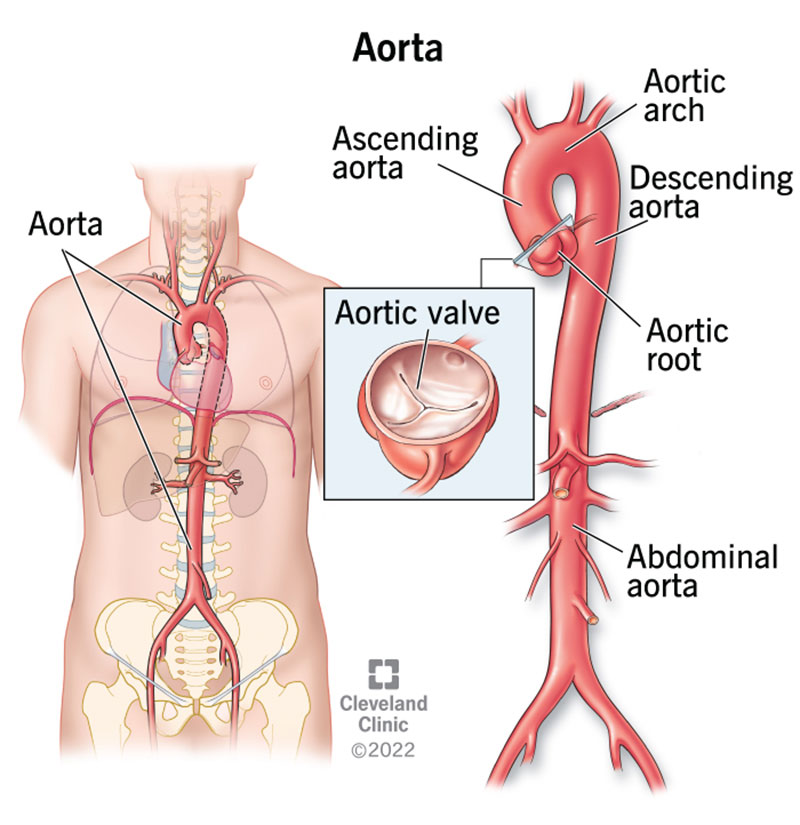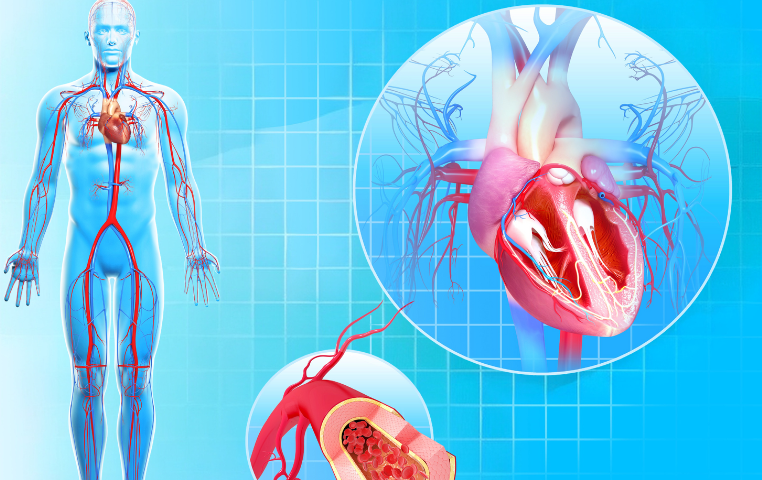Of all of the organs in my body – roughly 80 of them – there is one that has had the most life-changing impact on me in recent years. That is my aorta. I say that there are roughly 80 organs because if you ask Google, you will be told that there are 78 organs (note, it varies by gender); however, if you’ve been paying attention to the latest news coming from the aortic world as I have (how could you not?!), you may have seen that, as of February 2024, the aorta is now classified as a major organ.
My aortic aneurysm and the subsequent open heart surgery were a big reason behind the inception of WellTree. But what exactly is an aorta or an aortic aneurysm? Keep reading to learn that and more.
The Aorta: The Body’s Main Artery

As described by the Cleveland Clinic, the aorta is a cane-shaped artery. It starts in the lower left chamber of your heart (ventricle) and extends toward your head a short distance before curving down. The aorta passes through your chest and abdominal cavities and ends at your pelvis. Figure 1 illustrates the key parts of the aorta—the root (the widest part of the aorta), ascending aorta, arch, descending aorta, and abdominal aorta
The aorta’s primary function is to deliver oxygen-rich blood from the heart to the rest of your body. It also provides nutrients and hormones to internal organs and nearby supporting tissue. Think of the aorta as the main power lines that deliver electricity (oxygen-rich blood) from a power plant (your heart) to electrical substations (your organs). Are you with me?
Common Aortic Conditions and Their Impact
Much like a main power line that gets damaged and causes downstream interruptions, the aorta can cause severe complications that can be immediately life-threatening if things go wrong.
While there are various types of aortic diseases (you can find a comprehensive list here), aortic aneurysms and their much more severe cousins – aortic dissections and aortic ruptures – are among the most serious as they can be deadly.
Understanding Aortic Aneurysms
An aneurysm is a balloon-like bulge in the artery. Aortic aneurysms occur in 5-10 people out of every 100,000. In 95% of cases, aneurysms develop asymptomatically, which is why aneurysms are often found incidentally when patients receive a CT Scan, MRI, or Ultrasound for another medical condition.
Aneurysms can occur in the chest (thoracic aortic aneurysm or TAA) or, more commonly, in the abdomen (abdominal aortic aneurysm or AAA).
In my case, my aneurysm was found because my doctor saw an abnormality when he performed an EKG during my annual physical. The abnormality that my doctor noticed led him to do an ultrasound, which showed an aneurysm in my aortic root. I followed up my physical with a CT scan, which more accurately confirmed and measured the size of the aneurysm. Mine was 4.7cm. A healthy aortic root will measure from 2.1-4.3cm and wil vary based on age, gender, and body surface, as documented in this NIH study.
Treatment Strategies for Aortic Aneurysms
The American College of Cardiology (ACC) guidelines call for surgical intervention with an aorta >5.5cm. However, that can vary based on the growth rate, family history, and other factors. That was the case with me as my surgeon decided to operate when my aorta grew to 4.9cm in one year. I’m thankful that he did because living with an aortic aneurysm is likened to living with a ticking time bomb. The sooner you can disarm the bomb, the better.
Undiagnosed aneurysms can lead to dissection, which occurs when blood splits the layers of the walls within the aorta. An aortic rupture occurs when the aneurysm bursts completely, causing bleeding inside the body.
Ruptured Abdominal Aortic Aneurysms are responsible for causing the death of over 5,000 people annually in the U.S., making it the 15th biggest killer overall and the 10th biggest killer for men aged 55 years, according to the NIH. They are often referred to as “the silent killer” due to the high mortality rates combined with the fact that they are usually undetected.
Risk Factors for Aortic Aneurysm
Given its grim reputation as the silent killer, it’s essential to understand the risk factors and take proactive steps if you are at risk. The most important thing to understand is your family history. According to the Society for Vascular Surgery (SVS), If a first-degree relative has had an AAA, you are 12 times more likely to develop an abdominal aortic aneurysm. Of patients in treatment to repair an AAA, 15–25% have a first-degree relative with the same type of aneurysm.
Other risk factors include reported by the NIH include:
- Age – Abdominal aortic aneurysms are most common in adults after age 65.
- Genetic Conditions – Marfans Syndrom, Bicuspid Aortic Valve (BAV), and others. Refer to the NIH site to see a complete list of genetic conditions
- Smoking – One of the main factors that increases your risk for an aortic aneurysm
- Stimulants – Cocaine increases your blood pressure and your risk for aortic aneurysm
- High Blood Pressure – The leading risk factor for thoracic aortic aneurysms but also a risk factor for abdominal aortic aneurysms
- Weight Lifting – Research has shown that weight lifting can spike one’s blood pressure causing the aorta to rupture
John Ritter’s Story: A Wake-up Call for Aortic Health
An aortic dissection can sometimes be confused with a heart attack because the symptoms are similar. That was precisely what happened to beloved actor John Ritter. He was rushed from the set of his TV show “8 Simple Rules” to the hospital in 2003 at the age of 54 after complaining of chest pain, as recounted by his wife Amy on The Today Show.
While the death rate within the first 48 hours of arriving in the hospital for aortic dissections has dropped from 37% in the 50s to 5.8%, it’s vitally important that the proper protocols are in place to maximize the odds of survival.
John Ritter’s wife, Amy, launched The Ritter Foundation to “spread awareness of aortic health and prevent unnecessary suffering through genetic research, widespread education, and radical advocacy. Their website is an indispensable resource for anyone dealing with an aneurysm or anyone who thinks they may have a family history or other risk factors. Their “Ritter Rules” are simple rules that can help you learn more about the condition and potentially save your life.
If you are at risk, talk to your doctor about screening for aortic aneurysm. The American Heart Association has published Guidelines for the Management and Diagnosis of Aortic Disease as a reference for doctors’ treatment. The Ritter Foundation is an excellent resource for learning more about Family Screening and Genetic Testing.
Taking Action Against Aortic Disease
As we’ve seen, understanding and managing the risks associated with aortic disease can be the difference between life and death. If you or a loved one fits the risk profile for aortic aneurysm—especially if there’s a family history of the condition—don’t wait for symptoms to take action. Talk to your healthcare provider about screening options today. Early detection is our best defense against this silent killer.
For more resources and support, visit the Ritter Foundation website and explore their comprehensive guides on aortic health. Remember, taking proactive steps today can save your life. Make your heart health a priority—schedule your screening now!

